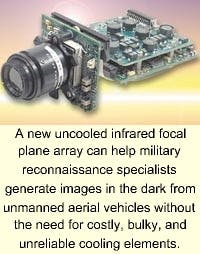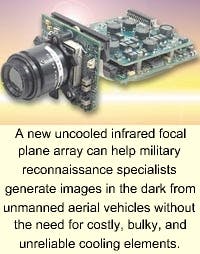By John McHale
NASHUA, N.H. — Engineers at Sanders, a Lockheed Martin Company in Nashua, N.H., demonstrated a night vision imaging sensor using uncooled focal plane array technology. Most military-quality IR focal plane arrays require special cooling devices.
Sanders demonstrated the uncooled IR sensor on the company's Micro Air Vehicle (MAV).
The air vehicle, called ROVIR for Remote Observation Vehicle Infrared, had an uncooled microbolometer sensor — a device that measures radiant heat — built by Sanders Infrared Imaging Systems business area in Lexington, Mass. The infrared sensor demonstrated the feasibility of covert close-in reconnaissance and intelligence gathering at night and collected performance data for further system development, company officials say.
"The real time IR imagery of buildings, auto-mobiles, power lines, and people that we collected was remarkable in its quality," says Sanders IR Sensor Program Manager Jack Miller. "The microbolometer technology is unique because of its ability to generate images in the dark without costly and bulky cooling devices required by competing technologies."
Because of the MAV's small size — it has a wingspan of only 42 inches — there is no room for a cooler, therefore uncooled microbolometer technology was ideal for it, Miller explains.
Miller explains that thermal energy, received through the lens of the camera, collects on micro plates, or pixels, which cause the plate's electrical properties to change. An array of these plates then forms a visible image of the scene, he adds.
Uncooled arrays have a much lower cost, higher reliability, smaller size, and use less power than cooled arrays such as mercury cadmium telluride, says Margaret Kohin, manager for uncooled technology at Sanders.
The majority of the electronics in the camera are custom designed, Kohin says. Commercial digital signal processors and field programmable gate arrays are used in the camera, but Kohin declined to comment on specific vendors.
Officials of the U.S. Defense Advanced Projects Agency (DARPA) are finally pushing forward and within the next two to three years there may be some use of the technology in satellite systems, Miller notes.
The uncooled IR camera is also a true dual-use application with firefighters using the technology in the commercial world to see through the smoke, Kohin adds.
Sanders Advanced Systems and Technology and the Lockheed Martin Skunk Works in Palmdale, Calif., are developing and demonstrating small-wingspan air vehicles such as the MAV for various military applications under a DARPA contract.




